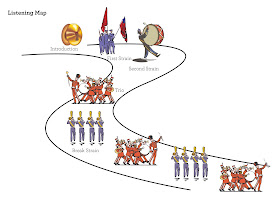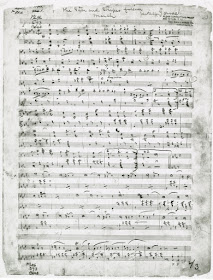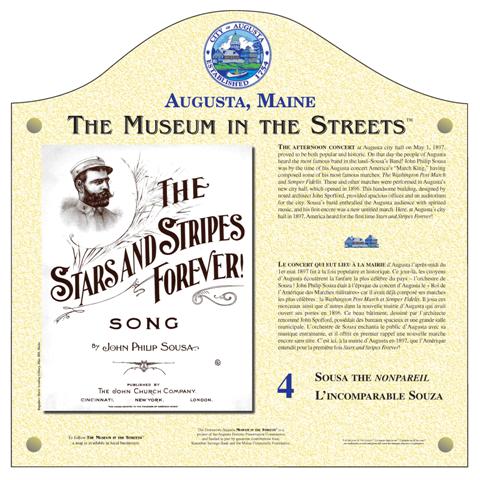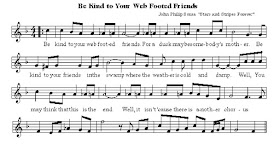"Which of these two powers, love or music, can
elevate us to sublimest heights? Why separate
them? They are the two wings of the soul."
AUTHOR: Hector Berlioz
COMPOSER
SOUSA



our greatest influence to our souls."
COMPOSER
SOUSA
Leonard Bernstein, Conductor
New York Philharmonic
 |
| The Stars and Stripes Forever Manuscript |
THE STARS AND STRIPES
FOREVER
Performed by the original
Sousa Band in 1909
Sousa Band in 1909
Introduction Spoken by Sousa
THE STARS AND STRIPES
FOREVER
(From the 1952 Movie)
https://www.youtube.com/watch?v=XU4A_qJ33pM

THE STARS AND STRIPES
FOREVER
FOREVER
(From the 1952 Movie)

THE STARS AND STRIPES
FOREVER
Piccolo Solo
Staff Sgt. Torin Olsen
of the West Point Band,
Piccolo Solo
of the West Point Band,
Piccolo Solo
(Excerpts taken from two separate
concerts live at West Point.)
concerts live at West Point.)
PICCOLO
What does the Piccolo look like?
The piccolo looks like a
tiny version of a flute.
tiny version of a flute.
The piccolo (Italian for small) is a half-size
flute; a type of transverse flute that is pitched
an octave above the concert (or standard)
flute is played and fingered in the same
manner. With a range of nearly three octaves
it reaches the highest pitches of a modern
orchestra. It is usually used for special effects
in orchestras but is more widely used in
concert and marching bands. There is usually
only 1 piccolo player in an orchestra because
it is so loud and high, that a single instrument
can cut through the sound of the entire group.
In the orchestra the piccolo (originally made
out of wood) was used in the Classical period
(second half of the 18th century) to imitate
sounds of nature such as birdsong or storms
and for special effects. In the 19th century
Romantic period Beethoven in his Fifth
Symphony, helped establish the instrument
as a regular part of the woodwind section in
the orchestra. The most familiar use of the
piccolo is in the end of John Philip Sousa's
"The Stars and Stripes Forever."
PICCOLO LINKS
In late 1896, while on vacation in Europe
with his wife, Sousa received word that
his good friend and band manager,
 |
| David Blakely |
had died suddenly. The band was
scheduled to begin another cross-
country tour soon so Sousa
quickly returned to the States
aboard the S.S. Teutonic
to take over the band's business affairs.
During the voyage back to the States,
pacing the deck of the ship, the music of
"The Stars and Stripes Forever" began to
come to him, its first stirring notes
 |
"Here came one of the most vivid incidents of my
career. As the vessel (the Teutonic) steamed out
of the harbor I was pacing on the deck, absorbed
in thoughts of my manager's death and the many
duties and decisions which awaited me in New York.
Suddenly, I began to sense a rhythmic beat of a band
playing within my brain. Throughout the whole tense
voyage, that imaginary band continued to unfold the
same themes, echoing and re-echoing the most
distinct melody. I did not transfer a note of that music
to paper while I was on the steamer, but when we
reached shore, I set down the measures that my
brain-band had been playing for me, and not
a note of it has ever changed."
"The Stars and Stripes Forever" was
first performed at Willow Grove Park
in southeastern Pennsylvania
(although this sign
from Augusta, Maine claims otherwise:
it states that this piece was first
performed there on May 1, 1897)
on May 14, 1897 where it earned
instant and rousing praise.
A local paper reported that,
(although this sign
from Augusta, Maine claims otherwise:
it states that this piece was first
performed there on May 1, 1897)
on May 14, 1897 where it earned
instant and rousing praise.
A local paper reported that,
"It is stirring enough to rouse the American eagle from
his crag, and set him to shriek exultantly while
he hurls his arrows at the aurora borealis."
After its premier, the
Philadelphia Post printed
"The critics pronounce it, barring 'The Washington Post'
[then Sousa's most famous march],
the greatest Sousa has yet written."
The Baltimore Sun, on May 18, 1897,
also reported the following:
"The fervid reception it met with caused the bearded
bandmaster to blush with pardonable pride to the
three themes and the final trio were
meant to typify the three sections
of the United States.
 |
(In 1897 Hawaii, Alaska, Arizona, New Mexico, and Oklahoma
had not been admitted into the Union yet.)
On this map Texas is partly in the West as well as in the South
|
The main theme represents the North,
 |
| http://lincolnsymphony.org/wp-content/uploads/2012/12/Sousaplan.pdf |
the piccolo solo the south,
and the theme of the West
is performed by the bold
countermelody in the trombones.
Since its premire Sousa's Band played
the march at almost every concert it held.
When it was played, the audience would
stand up as though it were the national
anthem. At first it was not unusual for
the band to play it two or three times in
a performance, each time receiving
louder applause than before. Sousa
played it for the last time on the
day he died, March 6, 1932.
 |
Last photo of Sousa with Eugene Wiedner
Conductor of the Ringgold Band
|
In 1987 "The Stars and Stripes Forever"
was declared the National March of the
and is considered to be Sousa's
most famous composition.
Although the piece is always played as an
instrumental Sousa penned a lengthy
and patriotically-charged set of lyrics that
fit virtually note-to-syllable with the music:
 |
| Jasper Johns: American Flag |
THE STARS AND STRIPES FOREVER
(Lyrics by John Philip Sousa, 1897)
THE STARS AND STRIPES
FOREVER
Barbershop Quartet Version
FOREVER
Barbershop Quartet Version
(Lyrics by John Philip Sousa, 1897)
https://www.youtube.com/watch?v=drba7wWZ5wg



INFORMATION FROM:
STARS AND STRIPES FOREVER
MUSICAL ANALYSIS
By Barrymore Laurence Scherer
http://online.wsj.com/article/SB10001424052702304898704577478520573394362.html
MUSICAL FORM

MUSICAL ANALYSIS
By Barrymore Laurence Scherer
http://online.wsj.com/article/SB10001424052702304898704577478520573394362.html
MUSICAL FORM
THE STARS AND STRIPES
FOREVER
Animated Listening Map 1
https://www.youtube.com/watch?v=RKRJe23Zths
https://www.youtube.com/watch?v=RKRJe23Zths
 |
| Star-Spangled Music 2010 |
THE STARS AND STRIPES
FOREVER
Animated Listening Map 2
https://www.youtube.com/watch?v=cx0RRdPdKcM












https://www.youtube.com/watch?v=cx0RRdPdKcM



SOME LISTENING
MAPS AND GUIDES






 |
| Ann Arbor Symphony Orchestra |



Like many Sousa marches, "The Stars and Stripes
Forever" opens with a four-bar introduction for the
full band in octaves that grabs our attention while
establishing the home key of E-flat major. The
opening strain, played mezzo forte, or moderately
loud, consists of two successive phrases for massed
clarinets and two cornets, characterized by tripping
dotted rhythms. This opening strain, with its relatively
lightweight instrumentation, is repeated. Then comes
the next strain, which old-time bandsmen
used to call the "release."





A march release actually lends the impression of
venting the brisk energy built up by the opening strain.
Here the melody characteristically broadens—the
earlier tripping rhythms yield to a somewhat broader
tune with wide intervals dominating the melodic arc.
And to reinforce this, Sousa presents this broader
melody fortissimo, or very loud, in octaves.

After the repetition of this second strain, Sousa moves
up four steps from the E-flat home key into A flat, for
the famous song like trio melody, played softly by the
clarinets, warmed by the combined tone of the solo
horn and three saxophones—baritone, tenor and alto—
and sweetened by the flute and piccolo in octaves. The
first eight-bar phrase of the trio is very narrow in range
and contains only five pitches from the E-flat on the
upbeat to the B-flat at the end of the phrase, which
makes it highly singable and easily memorized. Adding
energy to this melody, the soft accompaniment of chords
is a repeated rhythmic pattern boom-da-da-da-boom-
boom-da-da-da—descending from the fast cabaletta
movements of 19th-century Italian opera.

The conclusion of the trio leads to a tempestuous bridge
(or "breakstrain," in bandsman terminology), whose loud,
dramatic harmony thrusts us suddenly from the dignified
A-flat major of the trio into the suspenseful implication of
minor keys. Sousa's alternation of rising and falling
gestures in different instrumental choirs suggests a
miniature battle scene. And here Sousa lets loose his
lower brasses: the horns, trombones and tuba playing
rapid descending notes that display their agility and
powerful ability to roar. Punctuated by cymbal crashes
like flashes of gunpowder, this brazen combat climaxes
with a majestic descending passage for the entire band in
unharmonized octaves, one of the most commanding
sounds that can be produced by an entire concert band or
symphony orchestra. After the stormy harmonies of the
battle, those resounding octaves further heighten our
sense of expectation, which is rewarded with the return of
the trio melody—marked "grandioso"—this time with a
brilliant, high flying counter melody for the piccolo.

Sousa now repeats this genuinely thrilling material—the
roaring brasses, the cymbal crashes, the tidal wave of
descending octaves. Again we feel the anticipation, and
again we are rewarded with the final return of the trio
melody in all its contrapuntal glory, enriched with the
piccolo obbligato and another broad counter melody by
the trombones. Indeed this unforgettable finale almost
suggests poet Francis Scott Key's "star-spangled banner"
waving proudly above the shot and shell. And ever the
master showman who knew how to leave his audiences
wanting more, Sousa ends his grand musical fireworks
with one quick "stinger" chord for the entire band.

After the repetition of this second strain, Sousa moves
up four steps from the E-flat home key into A flat, for
the famous song like trio melody, played softly by the
clarinets, warmed by the combined tone of the solo
horn and three saxophones—baritone, tenor and alto—
and sweetened by the flute and piccolo in octaves. The
first eight-bar phrase of the trio is very narrow in range
and contains only five pitches from the E-flat on the
upbeat to the B-flat at the end of the phrase, which
makes it highly singable and easily memorized. Adding
energy to this melody, the soft accompaniment of chords
is a repeated rhythmic pattern boom-da-da-da-boom-
boom-da-da-da—descending from the fast cabaletta
movements of 19th-century Italian opera.

The conclusion of the trio leads to a tempestuous bridge
(or "breakstrain," in bandsman terminology), whose loud,
dramatic harmony thrusts us suddenly from the dignified
A-flat major of the trio into the suspenseful implication of
minor keys. Sousa's alternation of rising and falling
gestures in different instrumental choirs suggests a
miniature battle scene. And here Sousa lets loose his
lower brasses: the horns, trombones and tuba playing
rapid descending notes that display their agility and
powerful ability to roar. Punctuated by cymbal crashes
like flashes of gunpowder, this brazen combat climaxes
with a majestic descending passage for the entire band in
unharmonized octaves, one of the most commanding
sounds that can be produced by an entire concert band or
symphony orchestra. After the stormy harmonies of the
battle, those resounding octaves further heighten our
sense of expectation, which is rewarded with the return of
the trio melody—marked "grandioso"—this time with a
brilliant, high flying counter melody for the piccolo.

Sousa now repeats this genuinely thrilling material—the
roaring brasses, the cymbal crashes, the tidal wave of
descending octaves. Again we feel the anticipation, and
again we are rewarded with the final return of the trio
melody in all its contrapuntal glory, enriched with the
piccolo obbligato and another broad counter melody by
the trombones. Indeed this unforgettable finale almost
suggests poet Francis Scott Key's "star-spangled banner"
waving proudly above the shot and shell. And ever the
master showman who knew how to leave his audiences
wanting more, Sousa ends his grand musical fireworks
with one quick "stinger" chord for the entire band.
 |
| Ann Arbor Symphony Orchestra |



FOLLOW THE MELODY
ON THIS VIDEO
https://www.youtube.com/watch?v=qJtRPVXuuds













FOREVER
John Williams, Conductor
https://www.youtube.com/watch?v=G0Jf2AfyBKs









https://www.youtube.com/watch?v=qJtRPVXuuds



Many songs, both patriotic and
otherwise, have used the tune of The
Stars and Stripes Forever plus
there are many variations on how
the song is performed.


Probably the most widely recognized
rendering of it was the parody,
"Be Kind to Your Web-Footed Friends"
that regularly ended the popular
television program, "Sing Along with Mitch."
Hear the song at the end of this video:
BE KIND TO YOUR
WEB-FOOTED FRIENDS
(attributed to Fred Allen)
Be kind to your web-footed friends.
For a duck may be somebody's mother.
They live all alone in the swamp,
Where the weather is cold and damp.
Well, you may think that this is the end.
Yes, it is, but to prove that you are wrong,
We're going to sing it once again,
Oh, yes we will, but it will be just a bit louder!
Be kind to your web-footed friends.
For a duck may be somebody's mother.
They live at the bottom of the swamp,
Where the weather is cold and damp.
You may think that this is the end.
Well, it is ## you are right!
So, just remember:
Be kind to your web-footed friends!
Be ever kind, yes, oh, so kind to all the duckies!


STARS AND STRIPES
FOREVER
RECORDER QUINTET
(first page only)


THE STARS AND STRIPES
FOREVER
Performed by The Muppets




CARNEGIE HALL AND
THE STARS AND STRIPES
FOREVER CONNECTION
Carnegie Hall in New York City
was one venue where The Stars and
Stripes Forever found a near-
permanent home. It premiered there
almost exactly a year after being
published on January 28, 1898. The
blog at Carnegie Hall.org lists some
interesting facts about the piece as
it relates to its own history:
1. The Carnegie Hall premiere of
The Stars and Stripes Forever was
conducted by Frederick Brumm on
January 28, 1898—the year after it
was published. Proceeds from the
concert went to the "Fresh-Air
Department of the New York
Association for Improving the
Condition of the Poor."
and Stripes Forever has been
performed at Carnegie Hall just
over once a year on average.
This includes six graduation
ceremonies, two open rehearsals,
two 'meetings,' and one
1903 private event.
3. The longest spell between
performances of The Stars and
Stripes Forever at Carnegie Hall
was nearly six years—between
May 1981 and March 1987.
4. John Philip Sousa
conducted The Stars and Stripes
Forever three times at Carnegie Hall.
The first performance in 1905 and
two more on the same day,
October 6, 1917.
5. Famous Bach
transcriber Leopold Stokowski
conducted the Symphony of the
Air in a performance of The Stars
and Stripes Forever on April 16,
1960. Captain Kangaroo
is listed as 'Narrator'
for that concert. Stokowsky
also orchestrated The Stars and
Stripes Forever for orchestra:
THE STARS AND STRIPES
FOREVER
Leopold Stokowsky, Orchestrator
Leopold Stokowsky, Conductor
6. To celebrate becoming an
FOREVER
Leopold Stokowsky, Orchestrator
Leopold Stokowsky, Conductor
American citizen, legendary
pianist Vladimir Horowitz
wrote a transcription of The Stars
and Stripes Forever for solo piano.
He performed the New York
premiere in Carnegie Hall
on March 28, 1945.
and Stripes Forever for solo piano.
He performed the New York
premiere in Carnegie Hall
on March 28, 1945.
Vladimir Horowitz, Piano
THE STARS AND STRIPES
FOREVER
(Music Notation)
Vladimir Horowitz, Transcriber
conducted The Orchestra
of St. Luke's performing
The Stars and Stripes Forever six
times over three days at Carnegie Hall:
May 27 through 29, 2008—as part of
the Weill Music Institute's
Link Up school program.
8. New York Pops founder
Skitch Henderson
holds the record for conducting
The Stars and Stripes Forever in
front of an audience at Carnegie Hall.
Including two open rehearsals,
he did so eight times between
1989 and 2005.
9. Skitch would have made it nine
but he allowed a guest conductor to
step in for The Stars and Stripes
Forever on October 26, 2001. The
guest conductor?
Famed CBS anchorman
Walter Cronkite.
10. Star Wars, Jaws, Superman,
Indiana Jones, E.T., and Jurassic
Park film score composer and
conductor John Williams
Here is John Williams
conducting The Stars and Stripes
Forever at another venue:
THE STARS AND STRIPESFOREVER
John Williams, Conductor
LINKS
https://www.wikiwand.com/en/The_Stars_and_Stripes_Forever
http://www.davidwasser.com/music/sousaStarsStripes.asp
http://www.flutetunes.com/tunes.php?id=157
http://lincolnsymphony.org/wp-content/uploads/2012/12/Sousaplan.pdf
http://www.davidwasser.com/music/sousaStarsStripes.asp
http://www.flutetunes.com/tunes.php?id=157
http://lincolnsymphony.org/wp-content/uploads/2012/12/Sousaplan.pdf
https://www.bostonglobe.com/arts/music/2015/07
/04/sousa-greatest-hit-transformed-horowitz-hands/jVuG5GmPH0rzi32gBCsTdJ/story.html
/04/sousa-greatest-hit-transformed-horowitz-hands/jVuG5GmPH0rzi32gBCsTdJ/story.html
http://articles.baltimoresun.com/1997-05-18/news/1997
138194_1_stripes-forever-sousa-stars-and-stripes
http://www.musicedmagic.com/free-patriotic-sheet-music/
the-stars-and-stripes-forever-free-sheet-music.html
http://www.whatsoproudlywehail.org/wp-content/uploads/2013/05
/Sousa_The-Stars-and-Stripes-Forever.pdf?ac8fc1
138194_1_stripes-forever-sousa-stars-and-stripes
http://www.musicedmagic.com/free-patriotic-sheet-music/
the-stars-and-stripes-forever-free-sheet-music.html
http://www.whatsoproudlywehail.org/wp-content/uploads/2013/05
/Sousa_The-Stars-and-Stripes-Forever.pdf?ac8fc1
THE STARS AND STRIPES
FOREVER

































































